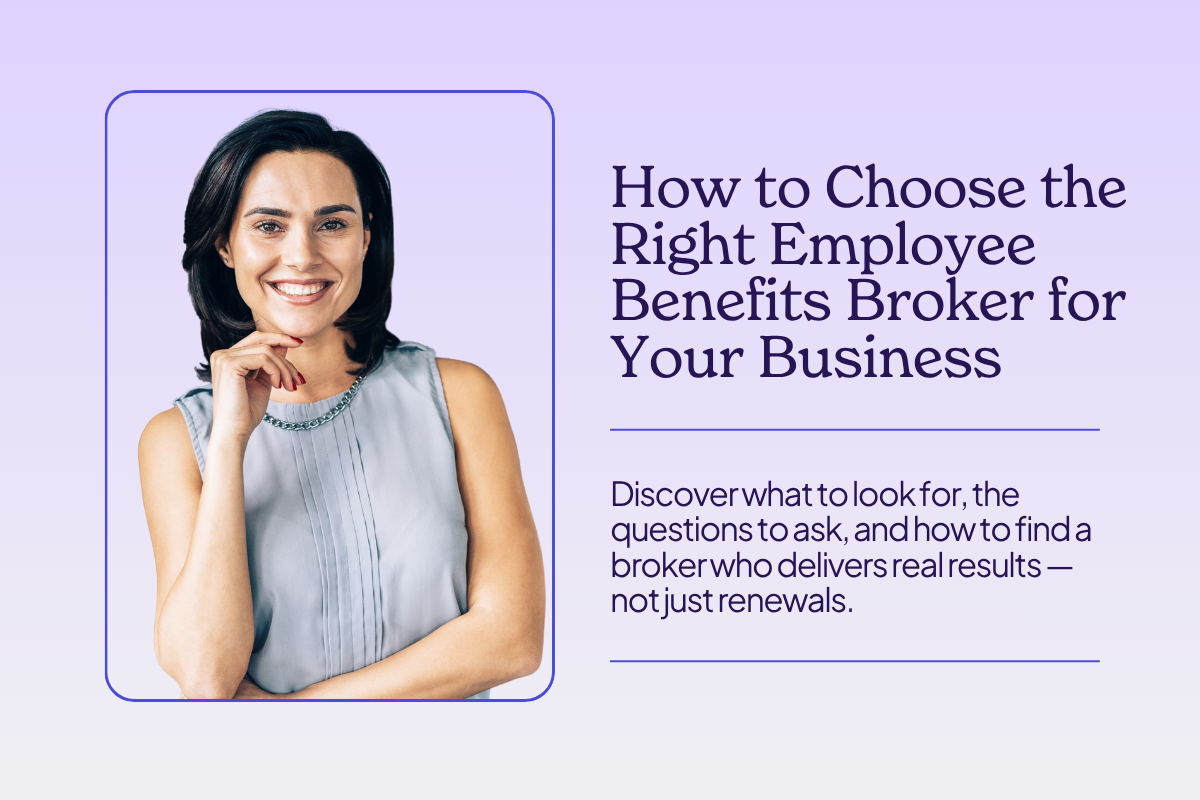How to Choose the Right Employee Benefits Broker for Your Business

If you’re responsible for managing benefits, you already know how much rides on the broker relationship. A good broker can make open enrollment smoother, control rising costs, and keep you ahead of compliance deadlines. They help you design a program that balances employee needs with organizational goals — and they’re often the first call you make when something goes wrong.
But even for experienced HR teams, finding the right broker isn’t always straightforward. The market is crowded, the service models vary, and everyone claims to be a “strategic partner.” You might already have a broker you like — or you might be starting to wonder if it’s time to make a change. Either way, it’s worth asking: What should a great benefits broker deliver?
This guide is here to help you answer that question. We’ll walk through what brokers actually do, how to spot the ones who bring real value, and the questions to ask before signing or switching. And because even the best broker can’t handle every piece of benefits administration, we’ll also explore how platforms like Selerix help HR teams keep the engine running — managing data, communications, and compliance once your strategy is set.
What Does an Employee Benefits Broker Do?
An employee benefits broker serves as your guide through one of the most complicated areas of HR: designing and managing employee benefits that meet both business goals and compliance requirements.
While it’s easy to think of brokers as middlemen between employers and insurance carriers, the good ones are much more than that. They’re consultants, problem-solvers, and advocates — people who understand your workforce, your budget, and the regulations that shape every decision you make.
Here’s what a strong broker relationship typically covers:
- Plan design and market analysis – Brokers help evaluate different carriers and plan types (medical, dental, vision, life, disability) to create a mix that fits your workforce.
- Carrier negotiation and renewal strategy – They negotiate rates, evaluate claims data, and manage renewals to keep costs sustainable year over year.
- Compliance and regulatory guidance – A knowledgeable broker provides guidance with laws like the ACA, ERISA, and COBRA, translating regulatory changes into clear next steps for your team.
- Employee education and enrollment support – Brokers often assist with enrollment campaigns, helping employees understand and value their benefits.
- Ongoing advisory support – The best brokers don’t disappear after renewal or open enrollment season. They act as year-round advisors, troubleshooting issues, analyzing utilization data, and anticipating what’s coming next.
Broker vs. Carrier vs. PEO: What’s the Difference?
It’s common for HR leaders to ask how a broker differs from an insurance carrier or a professional employer organization (PEO).
- Insurance carriers sell and underwrite the plans. They’re the ones providing coverage and processing claims.
- Employee benefit brokers act independently, representing your organization’s interests. They shop across multiple carriers to find plans and rates that fit your needs.
- PEOs offer bundled HR and payroll services, often including benefits, but you typically give up some control over plan design and carrier selection.
If you want flexibility, personalized guidance, and carrier choice, an employee benefits broker is usually the right partner.
How to Spot a Great Employee Benefits Broker
There’s no shortage of employee benefit brokers who can quote plans or manage renewals. But the great ones go much further — helping you think strategically about how benefits fit into your organization’s goals, culture, and workforce needs.
Here’s what to look for when evaluating or re-evaluating your broker partnership:
1. They’re proactive, not reactive.
A great broker doesn’t disappear after open enrollment. They check in regularly, bringing data, ideas, and updates before you have to ask. They help you plan for renewals early, anticipate market changes, and stay ahead of compliance shifts.
2. They understand your workforce.
Strong brokers take the time to learn who your employees are — from demographics to utilization patterns to communication preferences. Brokers can help simplify benefits choices. They help you design plans that resonate with both your people and your spreadsheets.
3. They’re transparent about compensation.
Trust is built on clarity. Your broker should be able to explain exactly how they’re compensated (commissions, fees, or both) and how those structures align with your company’s best interests.
4. They educate your employees and your HR team.
Benefits only work if people understand them. Great brokers partner with you on communication and enrollment strategies, offering materials, webinars, and employee education support that make complex benefits simple and boost employee satisfaction.
5. They embrace technology and collaboration.
The modern employee benefits insurance broker doesn’t just manage plans — they help you integrate them and find trusted partners to make them a reality. They understand how benefits administration platforms like Selerix streamline enrollment, compliance, and reporting, and they’re eager to connect their efforts with your HRIS systems and make them even better.
6. They bring ideas and options.
Good brokers show you quotes. Great brokers show you possibilities — creative funding models, voluntary benefits, wellness programs, and cost-containment strategies that make your plan stronger year after year. Brokers can help with health insurance and offer insight to guide a better employer deal.
When you find a broker who checks these boxes, you’ve found more than a service provider. You’ve found a strategic ally who can help you design benefits that work for your organization and your people.
Key Questions to Ask When Hiring an Employee Benefits Broker
Hiring or switching brokers can feel like a big commitment — and it is. The right employee benefits broker can help you save money, reduce administrative burden, and improve the employee experience for years to come. The wrong one can leave you managing the same old frustrations with higher costs and less clarity.
Before you sign (or re-sign) with a broker, ask questions that go beyond the proposal and get to the heart of how they’ll work with your team.
Strategy and Expertise
- How do you approach benefits strategy for organizations our size and industry?
- What trends or cost-saving strategies are you currently seeing among your clients?
- How do you evaluate whether our plans are competitive and aligned with market benchmarks?
Service Model and Support
- Who will be part of our day-to-day account team?
- How often will we meet outside of renewal season?
- What’s your process for handling escalations, compliance updates, or employee issues mid-year?
Communication and Employee Education
- How do you support employee engagement during open enrollment and beyond?
- Do you provide communication materials, virtual sessions, or decision-support tools?
- How do you measure the success of your employee education efforts?
Technology and Integration
- Which HR or benefits administration software do you commonly work with?
- How do you share data securely with our internal HR and payroll systems?
- Can you collaborate with our current technology partner (such as Selerix) to ensure seamless data flow and compliance?
Transparency and Accountability
- How are you compensated — and how do you make sure your incentives align with ours?
- What does your client retention look like?
- How do you track results and demonstrate value over time?
When a broker can answer these questions clearly, with examples and data to back them up, it’s a strong sign you’re dealing with a true partner — not just a policy middleman.
How Brokers and Benefits Administration Platforms Work Together
Once you’ve chosen the right broker, the next question is how to bring your strategy to life day-to-day — across enrollment, communication, and compliance. That’s where a benefits administration platform comes in.
A great employee benefits insurance broker helps you design and negotiate the plan. A great benefits administration partner helps you manage it. Together, they make sure your strategy doesn’t just look good on paper but actually runs smoothly in practice.
Here’s how the partnership typically works:
1. Brokers set the insurance product strategy.
Your broker helps you choose carriers, compare funding models, and structure plans that fit your workforce and budget. They bring compliance expertise, market data, and negotiation skills that keep your benefits competitive and cost-effective.
2. Benefits administration tools bring it to life.
Once the plans are finalized, platforms like Selerix take over the operational side — managing eligibility, enrollment, and communication across your employee base. The technology ensures employees can access their benefits easily, HR teams can track data accurately, and compliance requirements (like ACA and COBRA) are automatically supported.
3. Together, they simplify the employee experience.
When brokers and technology partners are aligned, employees get a seamless experience: clearer communication, easier enrollment, and fewer coverage errors. HR gets fewer manual tasks and more visibility into how benefits are being used and valued.
A strong broker-platform partnership gives you the best of both worlds — human expertise and reliable automation. Your broker helps shape the “what” and “why” of your benefits; your admin platform ensures the “how” happens smoothly, every day.
If your current systems or broker relationships aren’t working together this way, it may be time to reassess how your benefits ecosystem is connected.
Choosing the Right Employee Benefits Broker (and What Comes Next)
Selecting an employee benefits broker is one of the most impactful decisions you’ll make as an HR leader. The right partner doesn’t just find good rates — they help you design a benefits strategy that protects your people, strengthens engagement, and aligns with your organization’s long-term goals.
But once that strategy is in place, your work is just beginning. You still need to manage enrollments, communicate clearly, and stay compliant — all while keeping up with changing regulations and employee expectations. That’s where a strong benefits administration platform makes the difference.
With Selerix, HR teams and their brokers can manage everything in one place:
- Automated benefits administration that keeps eligibility, enrollment, and deductions accurate.
- Built-in compliance tools that handle ACA reporting, COBRA notices, and documentation.
- Communication features that help employees actually understand and appreciate their benefits.
If your broker helps you design a great program. Selerix helps you deliver it every day — clearly, compliantly, and confidently.Already working with a broker?
Learn how Selerix can support your benefits strategy with seamless administration, compliance, and communication tools that help your plans run as smoothly as they’re designed.
Explore Benefits Administration Solutions

